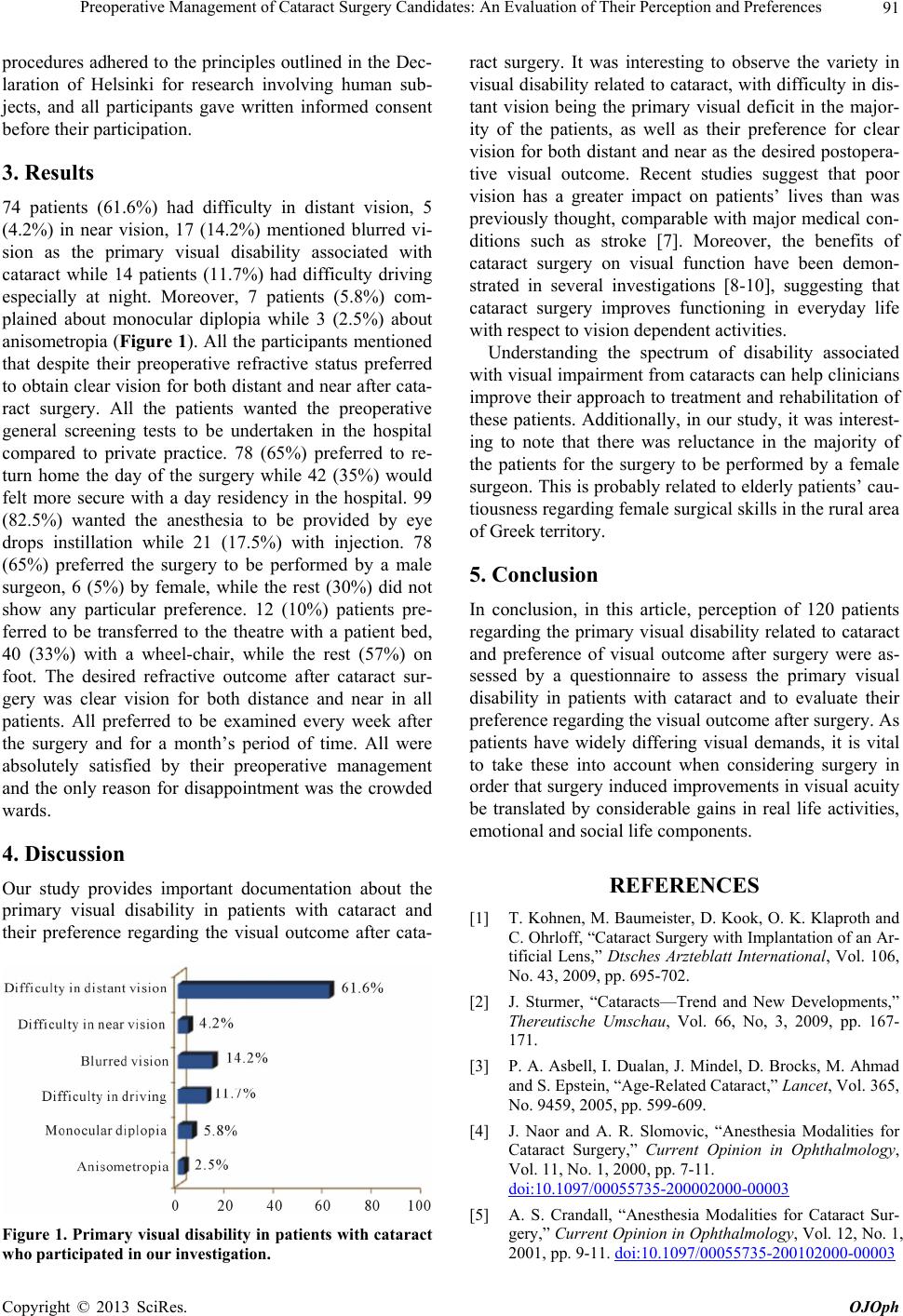
Preoperative Management of Cataract Surgery Candidates: An Evaluation of Their Perception and Preferences 91
procedures adhered to the princip les outlined in the Dec-
laration of Helsinki for research involving human sub-
jects, and all participants gave written informed consent
before their participatio n.
3. Results
74 patients (61.6%) had difficulty in distant vision, 5
(4.2%) in near vision, 17 (14.2%) mentioned blurred vi-
sion as the primary visual disability associated with
cataract while 14 patients (11.7%) had difficulty driving
especially at night. Moreover, 7 patients (5.8%) com-
plained about monocular diplopia while 3 (2.5%) about
anisometropia (Figure 1). All the participants mentioned
that despite their preoperative refractive status preferred
to obtain clear vision for both distant and near after cata-
ract surgery. All the patients wanted the preoperative
general screening tests to be undertaken in the hospital
compared to private practice. 78 (65%) preferred to re-
turn home the day of the surgery while 42 (35%) would
felt more secure with a day residency in the hospital. 99
(82.5%) wanted the anesthesia to be provided by eye
drops instillation while 21 (17.5%) with injection. 78
(65%) preferred the surgery to be performed by a male
surgeon, 6 (5%) by female, while the rest (30%) did not
show any particular preference. 12 (10%) patients pre-
ferred to be transferred to the theatre with a patient bed,
40 (33%) with a wheel-chair, while the rest (57%) on
foot. The desired refractive outcome after cataract sur-
gery was clear vision for both distance and near in all
patients. All preferred to be examined every week after
the surgery and for a month’s period of time. All were
absolutely satisfied by their preoperative management
and the only reason for disappointment was the crowded
wards.
4. Discussion
Our study provides important documentation about the
primary visual disability in patients with cataract and
their preference regarding the visual outcome after cata-
Figure 1. Primary visual disability in patients with cataract
who participated in our investigation.
ract surgery. It was interesting to observe the variety in
visual disability related to cataract, with difficulty in dis-
tant vision being the primary visual deficit in the major-
ity of the patients, as well as their preference for clear
vision for both distant and near as the desired postopera-
tive visual outcome. Recent studies suggest that poor
vision has a greater impact on patients’ lives than was
previously thought, comparable with major medical con-
ditions such as stroke [7]. Moreover, the benefits of
cataract surgery on visual function have been demon-
strated in several investigations [8-10], suggesting that
cataract surgery improves functioning in everyday life
with respect to vision dependent activities.
Understanding the spectrum of disability associated
with visual impairment from cataracts can help clinicians
improve their approach to treat ment and rehabilitation o f
these patients. Additionally, in our study, it was interest-
ing to note that there was reluctance in the majority of
the patients for the surgery to be performed by a female
surgeon. This is pr obably related to elderly patients’ cau-
tiousness regarding female surgical skills in the rural area
of Greek territory.
5. Conclusion
In conclusion, in this article, perception of 120 patients
regarding the primary visual disability related to cataract
and preference of visual outcome after surgery were as-
sessed by a questionnaire to assess the primary visual
disability in patients with cataract and to evaluate their
preference regarding the visual outcome after surgery. As
patients have widely differing visual demands, it is vital
to take these into account when considering surgery in
order that surgery induced improvements in visual acuity
be translated by considerable gains in real life activities,
emotional and social life co mponents.
REFERENCES
[1] T. Kohnen, M. Baumeister, D. Kook, O. K. Klaproth and
C. Ohrloff, “Cataract Surgery with Implantation of an Ar-
tificial Lens,” Dtsches Arzteblatt International, Vol. 106,
No. 43, 2009, pp. 695-702.
[2] J. Sturmer, “Cataracts—Trend and New Developments,”
Thereutische Umschau, Vol. 66, No, 3, 2009, pp. 167-
171.
[3] P. A. Asbell, I. Dualan, J. Mindel, D. Brocks, M. Ahmad
and S. Epstein, “Age-Related Cataract,” Lancet, Vol. 365,
No. 9459, 2005, pp. 599-609.
[4] J. Naor and A. R. Slomovic, “Anesthesia Modalities for
Cataract Surgery,” Current Opinion in Ophthalmology,
Vol. 11, No. 1, 2000, pp. 7-11.
doi:10.1097/00055735-200002000-00003
[5] A. S. Crandall, “Anesthesia Modalities for Cataract Sur-
gery,” Current Opinion in Ophthalmology, Vol. 12, No. 1,
2001, pp. 9-11. doi:10.1097/00055735-200102000-00003
Copyright © 2013 SciRes. OJOph